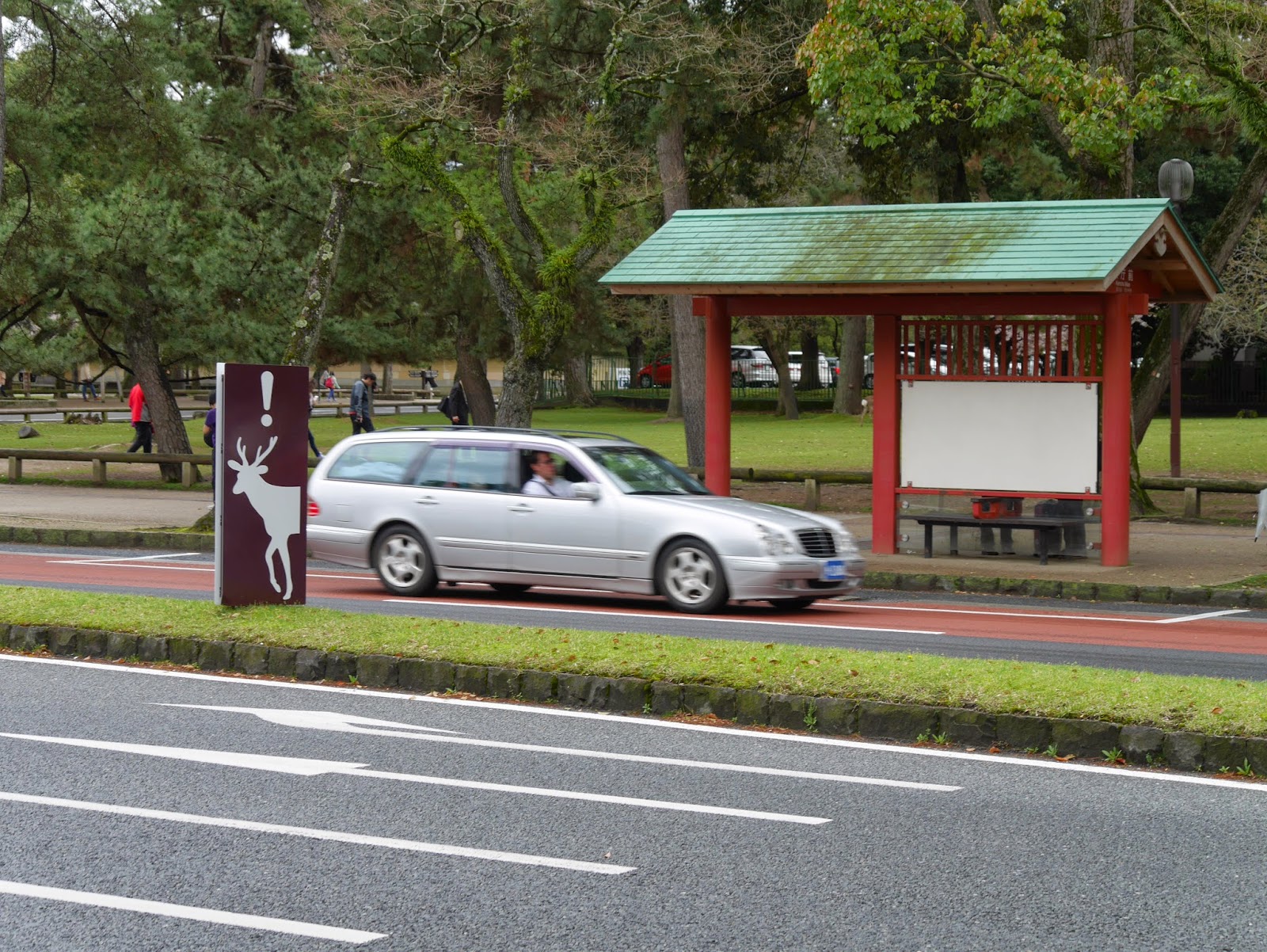We came to Nara, an ancient capital 1300 years ago, early in the morning.
 |
| Nara Station |
 |
| Sanjo-dori street |
Empress Genmei moved the capital from Fujiwara-kyo (kyo means capital, present-day Kashihara in Nara Prefecture) to Heijyo-kyo, which is the present-day Nara City, in 710. The royal family believed in Buddhism deeply at ancient times, so there are a lot of temples built in the surrounding of Heijyo-kyo. Among these temples, 7 of them, which collectively called as Nanto Shichi Daiji (The Seven Great Temples of Southern Capital), were still preserved until today.
However, due to the political interference from Buddhist temples, Emperor Kanmu moved the capital again to Nagaoka-kyo (present-day south of Kyoto) at 784 to avoid Buddhism temples' influences.
There is another legendary cause, which made Emperor Kanmu decided to move his capital. Empress Inoe and Crown Prince Osabe died suddenly after a political struggle in 775. A decade later, the relatives of Emperor Kanmu were passed away one by one. This series of misfortune made the Emperor believe that the spirits of late Empress and Crown Prince cursed the death of his relatives and believed that relocation of capital could resolve it.
10 years later, Emperor Kanmu moved his capital again to Hei'an-kyo (present-day Kyoto City) due to a series of natural and man-made disasters. Nagaoka-kyo was abandoned without completion.
There is another legendary cause, which made Emperor Kanmu decided to move his capital. Empress Inoe and Crown Prince Osabe died suddenly after a political struggle in 775. A decade later, the relatives of Emperor Kanmu were passed away one by one. This series of misfortune made the Emperor believe that the spirits of late Empress and Crown Prince cursed the death of his relatives and believed that relocation of capital could resolve it.
10 years later, Emperor Kanmu moved his capital again to Hei'an-kyo (present-day Kyoto City) due to a series of natural and man-made disasters. Nagaoka-kyo was abandoned without completion.
After 15-minute walk along Sanjo-dori, we reached at the front of Kofuku-ji Temple.
 |
| Sarusawa-ike (ike means pond) in front of Kofuku-ji Temple |
Sarusawa Pond is a man-made pond built in 749. It is built for Hojyo-e (a Buddhism ritual of releasing animals as practicing abstention of killing) held by Kofuku-ji Temple. This pond has seven wonders, which are not clear, not muddy, no entrance of water, no exit of water, no frogs, no algae and no excessive fish.
Kofuku-ji Temple is the head temple of Hosso school of Buddhism. It's one of the Seven Great Temples of Southern Capital and Fujiwara's tutelary temple in medieval period. It's also the ninth stop of the 33 Saikoku's site.
Kofuku-ji Temple was built in 710 and experienced multiple fire and rebuild. It has more than 1300-year history.
 |
| One of the entrance of Kofuku-ji Temple |
 |
| Statue of Jizo-bosatsu (Earth-Treasury Bodhisattva) |
 |
| Nan'en-do (South Octagonal Hall) |
 |
| The front view of Nan'en-do |
 |
| Gojyu-no-to (Five-storied pagoda, far side) and the site of Nandaimon (South Main Gate, the platform at right). |
Gojyu-no-to was built in 730 by Empress Komyo. The current wooden pagoda was rebuilt in 1426 of Muromachi Era. It's the second highest wooden tower (50.1 meter) in Japan. The highest tower is Gojyu-no-to in To-ji Temple of Kyoto.
Inside the structure on the first level, enshrined around the central pillar are a Yakushi Triad (to the east), a Shaka Triad (to the south), an Amida Triad (to the west) and a Miroku Triad (to the north). All triads are made in Muromachi Era.
 |
| "Those who do evil will live in hell" (a verse from Hokkugyo, or Dhammapada) |
 |
| Herd of deer could be seen here. |
 |
| Tokon-do (East Golden Hall) |
Tokon-do has the same history as Gojyu-no-to, which constructed in Nara Period. Both buildings experienced multiple of destruction by fire and reconstruction. The current building was rebuilt in Muromachi Era. The copper-made Yakushi-butsu (Medicine Buddha) and other wooden statue of characters in Buddhism are enshrined in Tokon-do.
To the left of Tokon-do is Kokuho-kan (National Treasure Hall). A lot of statues of Buddha, Asura and the 10-disciples of Buddha are exhibited in the Hall. Most of them are more than thousand-year antique.
After visiting Kokuho-kan and Tokon-do, we headed north where Nara Park starts here. Other than tourists, herd of deer is the most in this area.
 |
| Senbei (Japanese rice crackers) for deer is sold here. |
 |
| This deer was so hungry that finished up the map dropped on the floor. |
 |
| Signage of "Beware of Deer" at dividing dike. |
We turned right after that and saw a lonely deer when we passed Nara National Museum. I fed it with some bread. I was surprised that the deer bowed to me a lot of times when I gave it the bread.
Next:
The Great Buddha of Nara, Todai-ji Temple





No comments:
Post a Comment